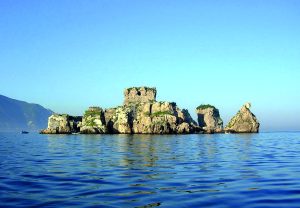Lo Scoglio di Rovigliano, anche noto come Petra Herculis è un piccolo isolotto calcareo nel Golfo di Napoli che racchiude secoli di storia, leggenda e architettura sul suo modesto territorio di appena 6 000 metri quadrati. Situato davanti alla foce del fiume Sarno, al confine tra Castellammare di Stabia e Torre Annunziata, è oggi disabitato ma custodisce tracce di un tempio antico, monasteri medievali, una torre di guardia e persino un ristorante novecentesco.
Geologicamente, lo scoglio condivide la composizione calcareo-dolomitica dei Monti Lattari e rappresenta forse la sommità di un’antica montagna affondata a seguito della collisione delle placche africana ed euroasiatica. La struttura è composta da rocce sedimentarie dolomitiche e calcaree affini ai Monti Lattari, suggerendo un’origine comune. È ipotizzabile che l’isolotto rappresenti la vetta di un antico rilievo franato in mare, processo legato alla collisione tra la placca africana e quella euroasiatica che ha modellato l’intera pianura campana. Nell’antichità lo scoglio era chiamato “Petra Herculis”: secondo la leggenda, Ercole staccò un blocco dal Monte Faito dopo la sua decima fatica e lo scagliò in mare, dando origine all’isolotto (storia riportata anche nei resoconti di Plinio il Vecchio, che menzionò il luogo prima di perire nell’eruzione del 79 d.C. proprio nei pressi dello scoglio). Durante l’epoca romana vi sorgeva un tempio dedicato a Ercole, di cui oggi rimane un tratto di muro in opus reticolatum.
Il nome “Rovigliano” compare per la prima volta in una bolla di papa Innocenzo III (inizi del XIII secolo), dove la località viene indicata come Rubellanium, forse dal cognome della gens Rubilia o dal termine latino “robilia” per le cicerchie che vi crescevano. Tra il VI e il XII secolo l’isolotto ospitò abitazioni private e poi un monastero cistercense riservato a giovani donne dedite alla vita monastica.
Nel XVI secolo fu costruita una torre di guardia per difendersi dalle incursioni saracene; le mura e le rovine sono ancora visibili. Dopo il 1860 lo scoglio passò al demanio statale e nel 1931 vi fu aperto un ristorante che però chiuse rapidamente, lasciando poche tracce.
Il fascino mitico richiama appassionati di archeologia e folklore classico, rendendo Scoglio di Rovigliano un simbolo delle radici antiche del territorio vesuviano. Oggi l’isolotto è raggiungibile solo via mare, con tour in barca da Torre Annunziata o Castellammare di Stabia, è meta di escursioni turistiche e conserva intatto il fascino della sua leggenda erculea.
Rovigliano, the historic Rock
The Rock of Rovigliano, also known as Petra Herculis, is a small limestone islet in the Gulf of Naples that encapsulates centuries of history, legend, and architecture on its modest territory of just 6,000 square meters. Located off the mouth of the Sarno River, on the border between Castellammare di Stabia and Torre Annunziata, it is now uninhabited but holds traces of an ancient temple, medieval monasteries, a watchtower, and even a twentieth-century restaurant.
Geologically, the rock shares the limestone-dolomitic composition of the Lattari Mountains and perhaps represents the summit of an ancient mountain that sank following the collision of the African and Eurasian plates. The structure is composed of dolomitic and limestone sedimentary rocks similar to the Lattari Mountains, suggesting a common origin. It is conceivable that the islet represents the peak of an ancient relief that slid into the sea, a process linked to the collision between the African and Eurasian plates that shaped the entire Campanian plain. In antiquity, the rock was called “Petra Herculis”: according to legend, Hercules broke off a block from Mount Faito after his tenth labor and threw it into the sea, giving rise to the islet (a story also reported in the accounts of Pliny the Elder, who mentioned the place before perishing in the eruption of 79 A.D. right near the rock). During the Roman era, a temple dedicated to Hercules stood there, of which a section of wall in opus reticulatum remains today.
The name “Rovigliano” first appears in a bull of Pope Innocent III (early 13th century), where the location is referred to as Rubellanium, perhaps from the surname of the gens Rubilia or the Latin term “robilia” for the vetchlings that grew there. Between the 6th and 12th centuries, the islet hosted private dwellings and then a Cistercian monastery reserved for young women dedicated to monastic life.
In the 16th century, a watchtower was built to defend against Saracen raids; the walls and ruins are still visible. After 1860, the rock became state property, and in 1931, a restaurant was opened there, but it closed quickly, leaving few traces.
Its mythical charm attracts enthusiasts of archaeology and classical folklore, making the Rock of Rovigliano a symbol of the ancient roots of the Vesuvian territory. Today, the islet is reachable only by sea, with boat tours from Torre Annunziata or Castellammare di Stabia, and is a destination for tourist excursions, preserving the intact charm of its Herculean legend.

 Italiano
Italiano











